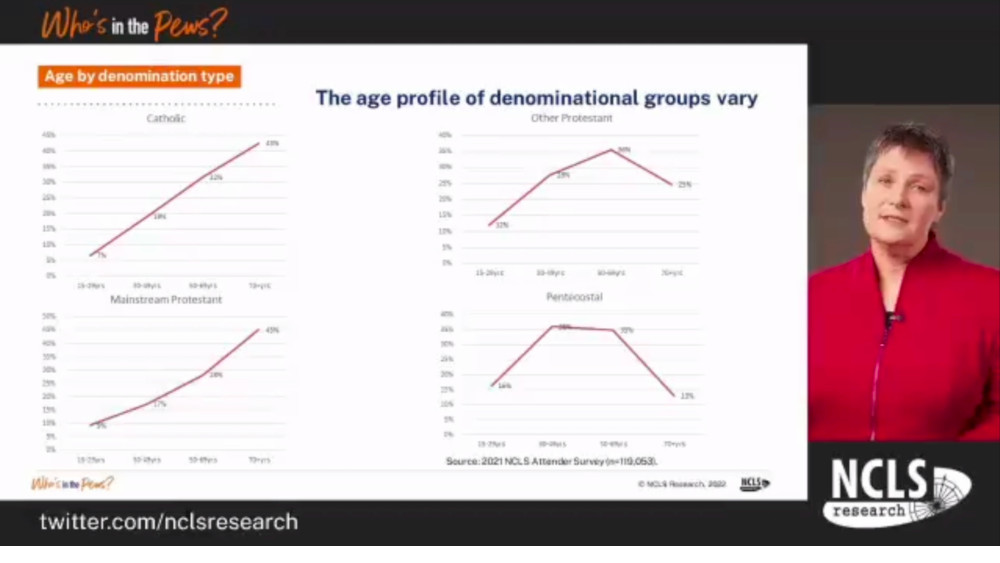The first results from Australia’s “church census” the National Church Life Survey” gives good news about committed young people and continuing church attendance.
The Covid effect has been overcome in churches according to NCLS’s Australian Community Survey (ACS). “November 21, Australians reported that they attended religious services at pre-pandemic levels 21%. The NCLS Director, Ruth Powell told a webinar releasing the results. ACS showed that a dip in 2019 to 16% had rebounded to 21% the next year, just 1% below the pre-covid level.
“We’ll be checking it again in November 2022,” Powell added.
1.6m Australians attend Church each week according to the 2016 NCLS, and 21 per cent at least once a month according to the 2021 ACS.
The NCLS tested a theory that Covid had affected the rusted on church attenders. “We have a solid committed core of around six in 10 church attenders with four in 10 who are changing their engagement,” Powell reported. “Two in 10 say they’re more involved while another two in 10 say they’re less involved.”
A possible Covid effect though was a dip in newcomers, with those attending a Protestant church for less than five years falling from 8.2 per cent in 2016 to 5.7 in 2021.
Another new fact from the 2021 survey was that around 4 in 10 church attenders, go to more than one church. “Around six in 10 Australian church attenders only attend one church,” Powell said. “However, around this core there are four in 10 or 38% who say they also attend elsewhere. They could pick two options. Some 26% said they attended in person and 17% online. Now, this is a particularly a Catholic pattern with more than half Catholics attending mass elsewhere, but even 26% of Protestants say they do so 15% of Protestants go in person somewhere else and 15% say at they attend online.
Education
The NCLS confirmed that people who go to church are more likely to have university degrees than the general population. As Australians become more likely to go to university, churchgoers with degrees are also increasing. “Some 19% of attenders have a postgraduate degree or diploma,” Powell reported. “25% have bachelor degrees. That makes 44%, 17% have a diploma and 10% have a trade certificate. 30% have completed primary or secondary school, which is closely linked to the older age profile of attenders.”
One interesting figure is that migrants in church have more education. 57% of those from non-English speaking countries who took part in the NCLS have degrees compared to 39% of Australian-born attenders.
Presbyterian (53%), Anglican (51%), and Baptist 951%0 are the denominations with the most attenders with degrees.
Powell used a striking metaphor to describe the effect the boomer generation has had on church. “If you imagine recent decades as a python, then the baby boomers are like the mouse swallowed by that python, which bulges out at each point making a huge impact as it passes through. This generational cohort filled the Sunday schools in the 1950s. Then in the sixties and seventies, they left church life as young adults. Mostly they did not come back and they did not bring their children back. And the consequences of this major disruption continue to impact on today’s church.
“So where are we at now? We’re just going to consider those aged 15 years. In 1991, 10% of Australians were aged 70 plus. By 2021, 15% were aged 70 years and over. In the church in 1991, 16% of churchgoers were aged 70 plus. By 2021, 36% of all attenders are aged over 70. Now there are distinct differences between movements. Catholics and mainstream Protestant attenders have the oldest age profile and, in contrast, Pentecostal churches have the youngest age profile.”
Young and Old
In contrast to the aging church – a factor underlined by the 2021 results that show 36% of all attenders are aged 70 plus, up from 16% in 1991 – the NCLS found a committed group of 15 to 30-year-olds in some churches.
“Young adults in church are most likely of any age group to report that they’ve experienced much growth in faith, that they are fully confident that their local church can achieve what it’s set out to do and that they would support the development of new initiatives of their church, “ Powell reported. “In terms of leadership development, they are also more likely to say than any other age group that their gifts and skills are encouraged to a great extent by the leadership and that they have leadership or ministry roles. Further, they tell us they want to be more involved. What an encouraging picture.”
Image: NCLS Webinar with Ruth Powell

